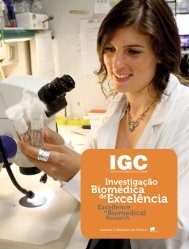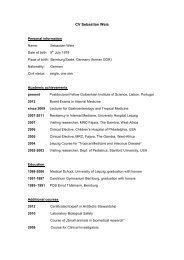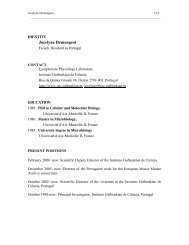organisation - the Instituto Gulbenkian de Ciência
organisation - the Instituto Gulbenkian de Ciência
organisation - the Instituto Gulbenkian de Ciência
- No tags were found...
Create successful ePaper yourself
Turn your PDF publications into a flip-book with our unique Google optimized e-Paper software.
DISEASE<br />
GENETICS<br />
Carlos Penha Gonçalves Principal Investigator<br />
PhD in Immunology, University of Umea, 1999<br />
Full Professor, Universida<strong>de</strong> <strong>de</strong> Lisboa, Portugal<br />
Head of Genomics Unit<br />
Principal Investigator at <strong>the</strong> IGC since 2005<br />
Our scientific interests are concerned with <strong>the</strong> genetic basis of resistance/susceptibility<br />
to disease with special focus on malaria and diabetes. We aim to<br />
<strong>de</strong>velop research programmes based on <strong>the</strong> systematic analysis of individual<br />
genetic factors involved in disease resistance/susceptibility, both in humans<br />
and in mouse mo<strong>de</strong>ls. Two diseases are <strong>the</strong> focus of our work: malaria and<br />
type-1 diabetes (T1D). We aim to investigate <strong>the</strong> pathogenesis of <strong>the</strong>se diseases<br />
by combining cell and molecular biology methodologies with classical genetics<br />
techniques. In coming years a strong <strong>the</strong>me in <strong>the</strong> lab will be <strong>de</strong>ciphering <strong>the</strong><br />
role of particular cell types of <strong>the</strong> innate immune system in:<br />
1. Mediating pathogen-induced pathology (in pregnancy and cerebral malaria);<br />
2. Conferring infection resistance (in malaria liver stage);<br />
3. Shaping <strong>the</strong> responsiveness to auto-antigens (in T1D).<br />
PREGNANCY-ASSOCIATED MALARIA<br />
Pregnancy-associated malaria (PAM) is a severe clinical complication of P. falciparum<br />
infection threatening <strong>the</strong> life of <strong>the</strong> mo<strong>the</strong>r and <strong>the</strong> foetus. Infected red<br />
blood cells (iRBC) adhesion and sequestration in <strong>the</strong> placenta are <strong>the</strong> inaugural<br />
events in placental malaria pathology but key investigations on <strong>the</strong> pathogenesis<br />
mechanisms are not amenable in human placenta. We <strong>de</strong>veloped two mouse<br />
mo<strong>de</strong>ls of PAM using Plasmodium berghei ANKA infected BALB/c females enabling<br />
us to follow several lines of investigations:<br />
GROUP MEMBERS<br />
Luciana Moraes (Post-doc)<br />
Nadia Duarte (Post-doc)<br />
Ligia Deus (PhD stu<strong>de</strong>nt)<br />
Joana Corte-Real (PhD stu<strong>de</strong>nt, left in December)<br />
Joana Rodo (PhD stu<strong>de</strong>nt)<br />
Lur<strong>de</strong>s Duarte (PhD stu<strong>de</strong>nt)<br />
Elizabeth Ball (PhD stu<strong>de</strong>nt)<br />
COLLABORATORS<br />
Lars Hviid (University of Copenhagen, Denmark)<br />
Chris Jansen (Lei<strong>de</strong>n University Medical Center, Ne<strong>the</strong>rlands)<br />
Claúdio Marinho (Universida<strong>de</strong> <strong>de</strong> São Paulo, Brazil)<br />
Maria Mota (<strong>Instituto</strong> <strong>de</strong> Medicina Molecular, Portugal)<br />
Jon Clardy (Harvard Medical School, USA)<br />
Peter Crompton (National Institute of Health, USA)<br />
Taane Clark (London School of Hygiene and Tropical Medicine, UK)<br />
Rosário Sambo (Hospital Pediátrico <strong>de</strong> Luanda, Angola)<br />
Maria Jesus Trovoada (Centro Nacional <strong>de</strong> En<strong>de</strong>mias, S. Tomé e Príncipe)<br />
Dan Holmberg (University of Conpenhagen, Denmark)<br />
Linda Wicker (University of Cambridge, UK)<br />
FUNDING<br />
Fundação para a Ciência e a Tecnologia (FCT), Portugal<br />
Calouste <strong>Gulbenkian</strong> Foundation, Portugal<br />
• We use confocal and two-photon intra-vital microscopy techniques to measure<br />
<strong>the</strong> dynamics of increased adhesion of PAM parasite to <strong>the</strong> placenta<br />
tissue, in vivo;<br />
• We are testing <strong>the</strong> hypo<strong>the</strong>sis that PM is not driven by a systemic condition<br />
but is ra<strong>the</strong>r a heterogeneous and localised inflammatory process.<br />
We propose that locally-acting immuno-mediators provi<strong>de</strong>d by <strong>the</strong> foetal tissues<br />
would have a crucial role in recruiting cellular components to <strong>the</strong> inflammatory<br />
infiltrate.<br />
Two manuscripts summarise <strong>the</strong> results obtained in 2011:<br />
Intravital placenta imaging reveals microcirculatory impact on sequestration<br />
dynamics and phagocytosis of Plasmodium-infected erythrocytes (Submitted).<br />
Distinct placental malaria patterns caused by Plasmodium berghei-<strong>de</strong>rived<br />
strains that fail to induce cerebral malaria in <strong>the</strong> C57Bl/6 mouse (Submitted).<br />
PLASMODIUM DEVELOPMENT IN HEPATOCYTES<br />
The Plasmodium liver stage is an appealing target for <strong>the</strong> <strong>de</strong>velopment of strategies<br />
to control malaria infection and has been a source of promising candidate<br />
vaccines. During malaria liver stage infection single parasites infect individual<br />
hepatocytes and <strong>de</strong>velop into thousands of merozoites. This <strong>de</strong>velopmental<br />
process is largely asymptomatic and not amenable to study in humans, <strong>the</strong>refore<br />
malaria mouse mo<strong>de</strong>ls are instrumental in revealing parasite and host factors<br />
involved in <strong>the</strong> establishment of <strong>the</strong> liver stage infection. We propose to<br />
investigate mouse genetic mo<strong>de</strong>ls where we found alterations of liver parasite<br />
expansion with <strong>the</strong> aim of i<strong>de</strong>ntifying host factors that hin<strong>de</strong>r <strong>the</strong> regulation<br />
and efficiency of Plasmodium <strong>de</strong>velopment in <strong>the</strong> liver. For this purpose we will<br />
use an exclusive tool set that inclu<strong>de</strong>s a significant collection of relevant mouse<br />
strains and parasite mutants as well as our established expertise on mouse primary<br />
hepatocyte cultures and imaging techniques.<br />
IGC ANNUAL REPORT ‘11<br />
RESEARCH GROUPS<br />
55






